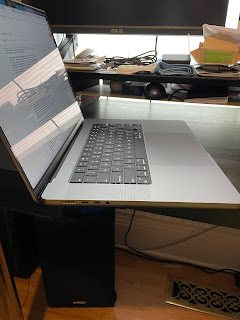On the importance of understanding use cases before buying technology, Part 1 (of undoubtedly many parts).
 |
| Puuuurrrty. |
 |
| This doesn't do the screen justice. It's really quite something. |
[This was, incidentally, also when I began my journey with network-attached storage and a centralized file server, because as it turned out, I had a lot of important files on those computers. I would eventually get most of the files I needed off the iMac, but the PC hard drive was DEAD dead, and I discovered the folly of storing any files on a PC on the hard drive with your system install. I won’t make that mistake again.]
I figured out pretty quickly that as beautiful as the MacBook Pro’s 16” screen is (and it is GORGEOUS), it was too small for a lot of what I wanted to do after a decade of working on 24+” screens. After some research (and seeing the price tag of the Apple Studio display), I bought a great ASUS ProArt Display, It’s not *quite* as nice as the Apple display, but was about a third of the cost and is a USB-C monitor that doubles as a dock/hub so I don’t have to keep plugging and unplugging mice, keyboards, headphones, etc. At the time, I thought “This is great! This is exactly what I need for working in my house, and I can take it and my files with me whenever I go!”
 |
| The current setup. |
I had committed a classic Phil blunder when it comes to technology: I had not considered my real use case(s), and had gone for the MOAR POWER IS MOAR approach with the top middle tier configuration. And ended up, as a result, with a stunningly pretty paperweight.
 |
| An expensive paperweight. |
I really have three use cases for computers at this point in my life:
1. A reasonably safe and secure desktop computer for things like banking, storing important files, doing my budget, managing my network, etc.
2. An easily-portable computer for word processing and web surfing and things like that.
3. A computer for gaming/video editing (admirably filled by my gaming PC, now that I’ve replaced the failed hard drive with a 2TB SSD, split my file management and system installs across different hard drives, and created network storage for backups)
For neither of the first two use cases did I need the power of a MacBook Pro. And, in fact, because of the way the Pro is designed (particularly the locations of the ports), it’s really bad as a desktop! I ended up buying another dock just to be able to plug things into the Pro without having to spend ten minutes readjusting my monitor afterwards, and even that makes it really difficult to get things plugged in or unplugged from the ports on the sides. Because of the size and weight and cost, it’s also pretty bad as an easily-portable computer, especially after four years of using a Surface tablet as my primary out-of-home machine.
 |
| The magnetic charging port is great! Unless it's tucked under a low shelf and moving it at all (or opening the blinds, or looking at it sideways) disconnects power. And that's actually a high-impedance headphone jack, which is great for an audiophile who likes hard-to-drive headphones like me. It's just nearly impossible to use when stored under a shelf. |
 |
| These ports are great! But totally useless under a shelf. |
In retrospect, I would have been much better off getting a Mac Mini for desktop use and a MacBook Air for on-the-go computing. Even at the time, it would have saved me a few hundred dollars. With the current generation, it would have saved me even more. And, in fact, as my Surface Pro has continued wearing out and slowing down, and with some trips planned in 2023, I ended up buying a M2 MacBook Air anyway a month ago on sale at Costco so I could have something to carry with me. So the Pro will 100% be a paperweight for the foreseeable future.
 |
| Almost nearly as pretty. |
 |
| Laptops that leave the house get cases. And stickers. |
C’est la vie.
[I'm honestly tempted to sell the Pro and buy an M2 Pro Mac Mini just because it seems like a real shame to use this beautiful piece of technology this way, but ... meh.]



Comments
Post a Comment